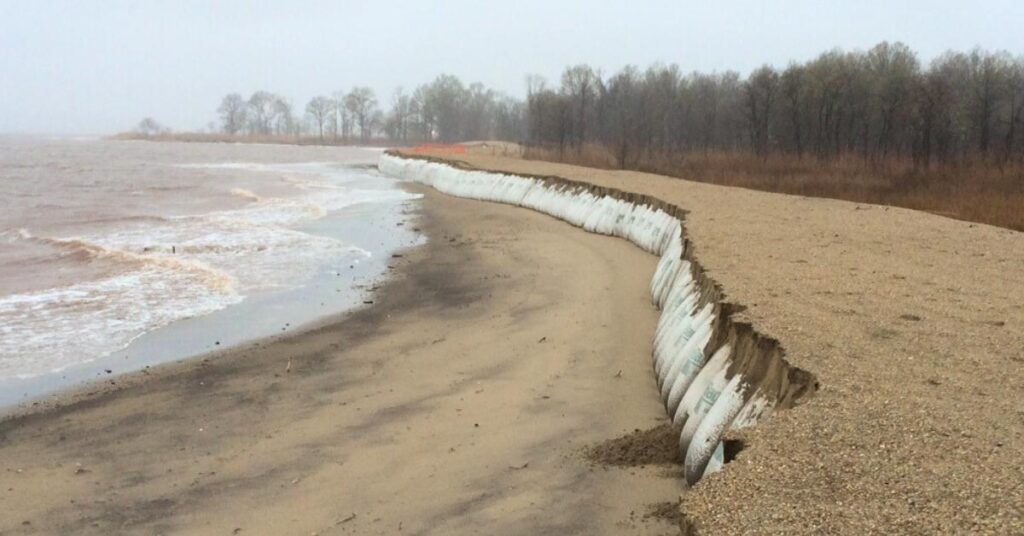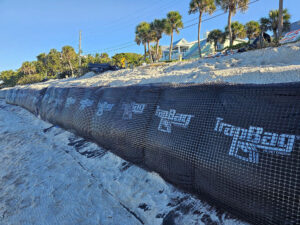Best Management Practices and Shoreline Protection Methods
Learn some of the best shoreline protection methods to prevent erosion and other issues with shoreline protection structures and natural methods.

Shorelines are an indispensable part of our environment. A healthy shoreline not only protects communities from destructive erosion, flooding, and lowered property values but also promotes biodiversity and flourishing ecosystems. Shoreline protection methods aid in the longevity of a plot of land’s value and environmental wellness, beautifying the shore and preserving its native wildlife.
What Causes Shoreline Degradation?
There are both natural and man-made causes of shoreline degradation. Storms and natural disasters, such as tornados, hurricanes, tsunamis, and floods, can cause monumental waves and high tides that crash down upon the shore and result in coastal erosion, which causes up to $500 million per year in property loss. These events are a natural part of our world’s climate and have been occurring since the dawn of time, but rising CO2 levels caused by human activities are making these disasters more frequent and severe.
Humans also directly contribute to shoreline degradation by building coastal structures, causing waves with boats, removing vegetation and sand from beaches, withdrawing nearby groundwater, and destroying dunes and grasses for land development. Learning about the human contribution to shoreline erosion is disheartening, but our influence also means we can interfere with prevention methods and positively impact the state of our shorelines.
Types of Shoreline Protection Methods
Man-Made Shoreline Protection Structures
Many types of shoreline protection methods involve the construction of man-made structures, such as jetties, breakwaters, groins, and seawalls. These are implemented along the shoreline or in shallow depths of the water to create resistance against waves and act as a barrier to rising tides that can cause flooding and erosion.
Natural Shoreline Protection Methods
Humans can also combat shoreline degradation by restoring or installing natural shoreline protection methods. Planting native vegetation like dune grass is an effective approach to shoreline erosion control. The friction prevents wind from freely blowing away the sediments that make up dunes. In areas where sand has already been severely eroded, sand replenishment is a viable technique for restoration.
Coral reefs protect shorelines by acting as a buffer for waves and turbulent currents in addition to blocking ship entry. Some artificial reefs have been implemented to replace the ones that have been destroyed by tourism and human activities. Any structure that provides a place for corals to grow on and marine creatures to hide in, such as cinder blocks, can act as an artificial reef.
Wetlands are another important ecosystem structure, and they’re disappearing at an alarming pace. The plant life in wetlands absorbs the impact of surface waters, and their dense root systems result in strong soil that isn’t easily swept away. In swampy coastal areas like Florida, wetlands like the Everglades are vital in preventing flooding and erosion.
Jetties, Groins, Seawalls, and Breakwaters
Jetties
A jetty is a long, narrow structure typically built of stone or cement designed to control inlet migration and the redeposition of sediment. These structures are particularly useful for areas where diagonal waves are caused by tropical storms. However, jetties can just as easily disrupt a natural ecosystem if they are not properly installed.
Groins
Similar to jetties, groins are structures built perpendicular to the shore. They restrict the transportation of shoreline sediment by capturing the longshore current and are built to protect long stretches of land from erosion. Sediment that is washed down the coast is collected on the updrift side of the structure.
Breakwaters
Breakwaters are structures built parallel to the shore that “break” waves, reducing the impact on the vulnerable sediment of the shoreline. They protect the shoreline in addition to marinas, harbors, anchorages, and basins. Made of rock and rubble, breakwaters are often submerged underwater but sometimes can be seen from above. This disruption of waves lessens the severity of shoreline erosion.
Seawalls
Seawalls, also known as retaining walls, play a significant role in beach restoration. Traditionally made from hard materials like rock, wood, and concrete, they protect against storm surges and are often made in emergencies because of their efficiency and quick construction. They can also accelerate erosion, so research before installation is important.
How to Protect Shorelines from Erosion and Flooding with TrapBag®
Dune Stabilization
Dunes are sand reservoirs that act as barriers against wind and water to keep shorelines intact. Flood bags like TrapBag can be used to stabilize dunes and strengthen the ecosystem of shorelines.
Because sand is such a lightweight substance, it is easily blown or flushed away by wind and water. This can make the stabilization of dunes a difficult task. Global rising sea levels pose a threat to sand dunes across the world, but TrapBag can reduce erosion by strengthening the dunes at their core and shielding dunes from low-lying wind gusts.
Shoreline Erosion Control with Structures
TrapBag can be used to create seawalls and other shoreline erosion protection structures. Shoreline erosion control demands sturdy products that won’t give way in the face of heavy wind and turbulent waves, and TrapBag’s high-strength textile design fits the bill. Due to the rapid deployment capabilities of our products, the construction of seawalls and breakwaters can be accomplished more quickly than with concrete or stone.
Flood Protection
Flood barriers are among the best methods of shoreline protection. Heavy, crashing waves and rising tides are disastrous for the well-being of shorelines. Flooding weakens dune ecosystems and damages vegetation that acts as a barrier against wind erosion. TrapBag’s flood barriers can withstand severe weather conditions, including hurricanes and thunderstorms. You can also protect your shoreline from flash floods by stocking up on flood barriers and having fill material ready on hand.
Get Shoreline Protection with TrapBag
Many property owners and environmental organizations are curious about how to protect shorelines from erosion. Whether for natural or man-made erosion solutions, TrapBag makes prevention simple. Our products have geotextile fabric for superior shoreline protection methods and longevity that will provide your shore with erosion protection for years. Environmental maintenance is an investment. Visit our shop and see for yourself why so many city governments and land management companies trust TrapBag.
Reliable Shoreline Protection

Prevent shoreline damage with TrapBag’s proven erosion control products. See for yourself why so many city governments and land management companies trust us.
